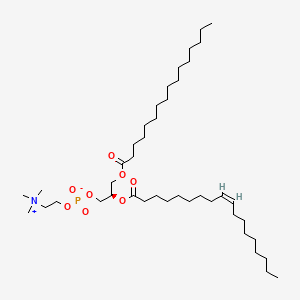
|
POPC |
POPC is a lipid of Glycerophospholipids (GP) class. Popc is associated with abnormalities such as Hyperlipidemia, Atherosclerosis, Type I Mucolipidosis, Coronary Arteriosclerosis and Coronary Artery Disease. The involved functions are known as phosphoglycerate dehydrogenase activity, Denaturation, immunoreactivity, high-density lipoprotein particle remodeling and Process. Popc often locates in high-density lipoprotein particle, viral nucleocapsid location, Plasma membrane, spherical high-density lipoprotein particle and Face. The associated genes with POPC are Mutant Proteins, SCARB1 gene, SPEN gene, Polypeptides and globular protein. The related lipids are Total cholesterol, i-cholesterol, Fatty Acids, cholesteryl oleate and Cholesterol/Phospholipid. The related experimental models are Genetically Engineered Mouse. |
3550 |
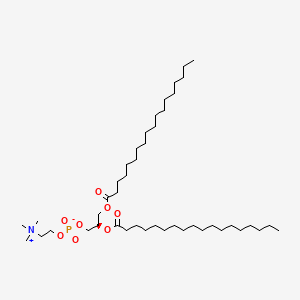
|
816-94-4 |
816-94-4 is a lipid of Glycerophospholipids (GP) class. 816-94-4 is associated with abnormalities such as Gigantism, Pulmonary Hypertension, Neutropenia, Serum Sickness and Urticaria. The involved functions are known as pulmonary effects, Hemodynamics, Stereochemistry, Host defense and Blood Circulation. 816-94-4 often locates in vesicle, Blood, biological membrane, soluble and Cardiopulmonary. The associated genes with 816-94-4 are pentaglobulin, EMILIN1 gene and FASTK Gene. The related lipids are Liposomes, dimyristoylphosphatidylglycerol, Lipopolysaccharides, Unilamellar Liposomes and Unilamellar Vesicles. |
828 |
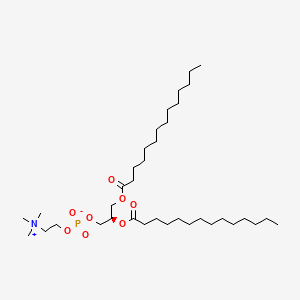
|
18194-24-6 |
18194-24-6 is a lipid of Glycerophospholipids (GP) class. 18194-24-6 is associated with abnormalities such as Cerebrovascular accident, Renal tubular disorder, Atherosclerosis, Hyperlipoproteinemia Type III and Lipid Metabolism Disorders. The involved functions are known as Process, protein folding, Catalyst, Biochemical Pathway and Fold in Medical Device Material. 18194-24-6 often locates in Tissue membrane, Membrane, periplasm, vesicle membrane and outer membrane. The associated genes with 18194-24-6 are Integral Membrane Proteins, Protein Structure, RTN4 gene, RTN4R gene and Protein, Organized by Structure. The related lipids are Micelles, dimyristoylphosphatidylglycerol, 1,2-dihexadecyl-sn-glycero-3-phosphocholine, Unilamellar Vesicles and cholesteryl oleate. The related experimental models are Mouse Model, Arthritis, Adjuvant-Induced, Disease model and Xenograft Model. |
6350 |

|
Platelet activating factor |
Platelet activating factor is a lipid of Glycerophospholipids (GP) class. Platelet activating factor is associated with abnormalities such as Atherosclerosis, Acute cholecystitis without calculus, Cholecystitis, Colitis and Cholecystitis, Acute. The involved functions are known as Cell Survival, Metabolic Inhibition, lipid oxidation, Apoptosis and Oxidation. Platelet activating factor often locates in soluble, Cellular Membrane, Smooth muscle (tissue), Intima and Tissue specimen. The associated genes with Platelet activating factor are apolipoprotein A-I Milano, Homologous Gene, TSPO gene, HBEGF gene and SLC33A1 gene. The related lipids are Hydroxycholesterols, Liposomes, 25-hydroxycholesterol, Lysophosphatidylcholines and Lipopolysaccharides. The related experimental models are Knock-out, Mouse Model and Transgenic Model. |
7383 |

|
PE(15:0/20:0) |
PE(15:0/20:0) is a lipid of Glycerophospholipids (GP) class. Pe(15:0/20:0) is associated with abnormalities such as Exanthema, Infection, Painful Bladder Syndrome, Obesity and Fatty Liver. The involved functions are known as conjugation, Transcription, Genetic, Sinking, Autophagy and Protein Biosynthesis. Pe(15:0/20:0) often locates in membrane fraction, soluble, Membrane, Body tissue and Tissue membrane. The associated genes with PE(15:0/20:0) are GABARAPL2 gene, ATG10 gene, ATG12 gene, SLC33A1 gene and GABARAP gene. The related lipids are Liposomes, Lipopolysaccharides, Phosphatidylserines, Membrane Lipids and Cardiolipins. The related experimental models are Knock-out and Cancer Model. |
723 |

|
trichostatin A |
Trichostatin is a lipid of Polyketides (PK) class. Trichostatin is associated with abnormalities such as Dentatorubral-Pallidoluysian Atrophy, PARAGANGLIOMAS 3, abnormal fragmented structure, Disintegration (morphologic abnormality) and Hyperostosis, Diffuse Idiopathic Skeletal. The involved functions are known as Acetylation, Cell Differentiation process, histone modification, Gene Silencing and Transcriptional Activation. Trichostatin often locates in CD41a, Hematopoietic System, Chromatin Structure, Blood and Endothelium. The associated genes with Trichostatin are SPI1 gene, CELL Gene, Chromatin, CXCR4 gene and DNMT1 gene. The related lipids are Butyrates, Promega, butyrate, Lipopolysaccharides and Steroids. The related experimental models are Knock-out, Mouse Model, Xenograft Model and Cancer Model. |
5401 |
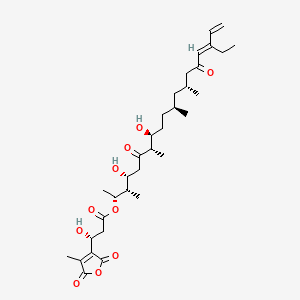
|
Tautomycetin |
Tautomycetin is a lipid of Polyketides (PK) class. Tautomycetin is associated with abnormalities such as Toxic nephropathy and Dehydration. The involved functions are known as Signal, Regulation, Increased Sensitivy, Increased Device Sensitivity and phosphoric monoester hydrolase activity. Tautomycetin often locates in Neurosecretory Systems, Protoplasm, Mitochondria, Transplanted tissue and Blood. The associated genes with Tautomycetin are RAF1 gene, IL2 gene, IL2RA gene, BCL2 gene and cytochrome c''. The related lipids are branched chain fatty acid and Propionate. |
102 |
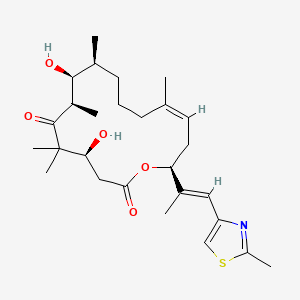
|
Epothilone D |
Epothilone d is a lipid of Polyketides (PK) class. Epothilone d is associated with abnormalities such as Tauopathies, Neutropenia, Neuropathy and Hematological Disease. The involved functions are known as Mutation, Apoptosis, Mitotic arrest, Cell Growth and Anabolism. Epothilone d often locates in Cytoskeleton, Axon, Cell Wall, Chromosomes and Spindle. The associated genes with epothilone D are SLC33A1 gene, Chromatin, GTF2I gene and HEXA gene. |
174 |

|
tacrolimus |
Tacrolimus is a lipid of Polyketides (PK) class. Tacrolimus is associated with abnormalities such as Renal glomerular disease. The involved functions are known as inhibitors, Fungicidal activity, Metabolic Inhibition, Excretory function and Dephosphorylation. Tacrolimus often locates in Hepatic, Mitochondrial matrix and Inner mitochondrial membrane. The associated genes with Tacrolimus are RHOA gene and BGN gene. |
12730 |
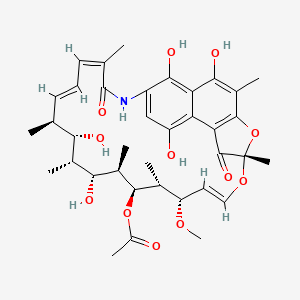
|
Rifamycin SV |
Rifamycin SV is a lipid of Polyketides (PK) class. Rifamycin sv is associated with abnormalities such as Cholestasis, Infection, Dysentery, Soft Tissue Infections and Osteomyelitis. The involved functions are known as Uptake, Excretory function, Drug Kinetics, inhibitors and anaphylaxis. Rifamycin sv often locates in Hepatic, Blood, soluble, Entire gastrointestinal tract and Membrane. The associated genes with Rifamycin SV are SLCO1C1 gene, SLCO1B1 gene, ABCB11 gene and SLC10A1 gene. |
287 |

|
minocycline |
minocycline is a lipid of Polyketides (PK) class. Minocycline is associated with abnormalities such as Infection, Soft Tissue Infections, Septicemia, Chronic hyponatremia and Lesion of brain. The involved functions are known as Pharmacodynamics, Gene Expression, Transcriptional Activation, Regulation and Process. Minocycline often locates in Ribosomes, 50S ribosomal subunit, Blood, Skin and Immune system. The associated genes with minocycline are THEMIS gene, KCNK2 gene, RBFOX3 gene, PIWIL2 gene and P4HTM gene. The related lipids are Lipopolysaccharides, Promega, Steroids, Liposomes and Octanols. The related experimental models are Mouse Model, Experimental Autoimmune Encephalomyelitis, Genetically Engineered Mouse, Disease model and spinal model. |
9780 |

|
CYTOCHALASIN B |
CYTOCHALASIN B is a lipid of Polyketides (PK) class. Cytochalasin b is associated with abnormalities such as Renal tubular disorder and Chagas Disease. The involved functions are known as Membrane Protein Traffic, inhibitors, Metabolic Inhibition, Biochemical Pathway and Increased Sensitivy. Cytochalasin b often locates in Cytoplasmic matrix, Plasma membrane, Microtubules, Extracellular and Protoplasm. The associated genes with CYTOCHALASIN B are SLC2A2 gene, PFDN5 gene, SLC2A1 gene, OMG gene and SPEN gene. The related lipids are Steroids, Lipopolysaccharides and Liposomes. The related experimental models are Xenograft Model. |
9648 |

|
(-)-Epigallocatechin gallate |
(-)-Epigallocatechin gallate is a lipid of Polyketides (PK) class. (-)-epigallocatechin gallate is associated with abnormalities such as IMMUNE SUPPRESSION, Infection, Nodule, Lymphopenia and Tumor Immunity. The involved functions are known as Apoptosis, Cellular Immune Response, Specific immune response, Signal and Infiltration. (-)-epigallocatechin gallate often locates in Immune system, Cytoplasmic Granules, Skin, Protoplasm and Body tissue. The associated genes with (-)-Epigallocatechin gallate are C8orf4 gene, Genes, vpr, MAPK8 gene, P4HTM gene and GAG Gene. The related lipids are Promega, Lipopolysaccharides, Palmitates, Fatty Acids and Sphingolipids. The related experimental models are Mouse Model, Xenograft Model, Transgenic Model, Experimental Autoimmune Encephalomyelitis and Arthritis, Collagen-Induced. |
6551 |

|
SCHEMBL105486 |
Kakonein is a lipid of Polyketides (PK) class. Kakonein is associated with abnormalities such as Fatty Liver, Chronic liver disease, Morphologically altered structure, Hypertensive disease and Cardiovascular Diseases. The involved functions are known as protein expression, Extravasation, Liver damage, mRNA Expression and cell activation. Kakonein often locates in Body tissue, Hepatic, Microvilli, Cytoplasm and Membrane. The associated genes with Kakonein are TJP1 gene, CD14 gene, iberiotoxin, AT-Rich Interactive Domain-Containing Protein 1A and NKS1 gene. The related lipids are dehydrosoyasaponin I and Steroids. The related experimental models are Knock-out. |
1391 |

|
daidzein |
daidzein is a lipid of Polyketides (PK) class. Daidzein is associated with abnormalities such as Cardiovascular Diseases, Osteoporosis, Heart Diseases, Thyroid Diseases and Exanthema. The involved functions are known as Cell Growth, Disease Progression, metaplastic cell transformation, Cell Cycle and M Phase Cell Cycle Arrest. Daidzein often locates in Urothelium, Mucous Membrane, Chromosomes, Epithelium and Ribosomes. The associated genes with daidzein are Tumor Suppressor Genes, Genome, TIRAP gene, TICAM2 gene and Candidate Disease Gene. The related lipids are Promega, Steroids, Saponins, enterodiol and linoleates. The related experimental models are Xenograft Model, Knock-out, Mouse Model, Breast Cancer Model and Arthritis, Experimental. |
4463 |

|
rotenone |
rotenone is a lipid of Polyketides (PK) class. Rotenone is associated with abnormalities such as Parkinson Disease, MYOPATHY, DISTAL, WITH ANTERIOR TIBIAL ONSET, Neurodegenerative Disorders, Septicemia and Respiratory Failure. The involved functions are known as Phosphorylation, Process, Cell Death, proteasome activity and Apoptosis. Rotenone often locates in Protoplasm, Presynaptic Terminals, Neurites, NADH dehydrogenase complex and Mitochondria. The associated genes with rotenone are DNAJB9 gene, EIF2S3 gene, Candidate Disease Gene, G-substrate and ERN1 gene. The related lipids are Lipopolysaccharides, Membrane Lipids, Phosphatidylserines, Fatty Acids and Cardiolipins. The related experimental models are Knock-out, Mouse Model, Disease model and Rodent Model. |
7079 |

|
HEMATOXYLIN |
HEMATOXYLIN is a lipid of Polyketides (PK) class. Hematoxylin is associated with abnormalities such as Eosinophilia, Duodenal Adenoma, Senile Plaques, Morphologically altered structure and Cervical abscess. The involved functions are known as Uptake, Apoptosis, Amplification, Necrosis and Karyopyknosis. Hematoxylin often locates in Body tissue, Extracellular, Compact bone, Skin and Basement membrane. The associated genes with HEMATOXYLIN are GAPDH gene, Genome, Elastin, MERTK wt Allele and P4HTM gene. |
6127 |
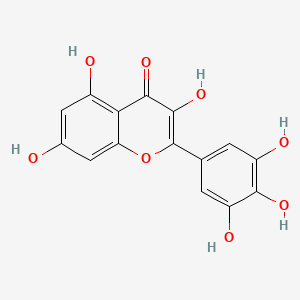
|
myricetin |
myricetin is a lipid of Polyketides (PK) class. Myricetin is associated with abnormalities such as Diabetes, First myocardial infarction, Diabetes Mellitus, Non-Insulin-Dependent, Asthma and Cataract. The involved functions are known as Cell Survival, inhibitors, Process, Metabolic Inhibition and Oxidation. Myricetin often locates in Fibril - cell component, soluble, Body tissue, Back and Tissue membrane. The associated genes with myricetin are HPGDS gene, P4HTM gene, CFLAR gene, SLC2A2 gene and SLC2A1 gene. The related lipids are Promega, Sterols, dipalmitoylphosphatidylserine, 1,2-oleoylphosphatidylcholine and Membrane Lipids. |
1801 |

|
quercetin |
quercetin is a lipid of Polyketides (PK) class. Quercetin is associated with abnormalities such as Coronary heart disease, Myocardial Infarction, Cirrhosis, Coronary Arteriosclerosis and Vascular ring. The involved functions are known as Vasodilation, physiological aspects, Fermentation, Process and Ingredient. Quercetin often locates in Arterial system, Endothelium, Skin, Endothelium, Vascular and Tissue specimen. The associated genes with quercetin are P4HTM gene, SULT gene, UGT1A1 gene, ARHGAP26 gene and PLXNB1 gene. The related lipids are blood lipid, Promega, Steroids, Phosphatidylserines and Fatty Acids. The related experimental models are Knock-out, Mouse Model, Xenograft Model, Tissue Model and Cancer Model. |
5377 |
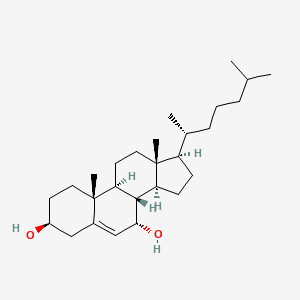
|
7alpha-Hydroxycholesterol |
7alpha-Hydroxycholesterol is a lipid of Sterol Lipids (ST) class. 7alpha-hydroxycholesterol is associated with abnormalities such as Atherosclerosis, Morphologically altered structure, Carotid Atherosclerosis, Myocardial Infarction and Cerebrovascular accident. The involved functions are known as Apoptosis, Cell Growth, Necrosis, Chromosome Condensation and Tissue Adhesions. 7alpha-hydroxycholesterol often locates in Arterial system, Endothelium, Cell Nucleus, Membrane and yolk. The associated genes with 7alpha-Hydroxycholesterol are acetyl-aspartyl-glutamyl-valyl-aspartal, BCL2 gene, OGFR gene, Genome and GAPDH gene. The related lipids are Hydroxycholesterols, 7-ketocholesterol, Ketocholesterols, 20-hydroxycholesterol and 25-hydroxycholesterol. |
225 |



















